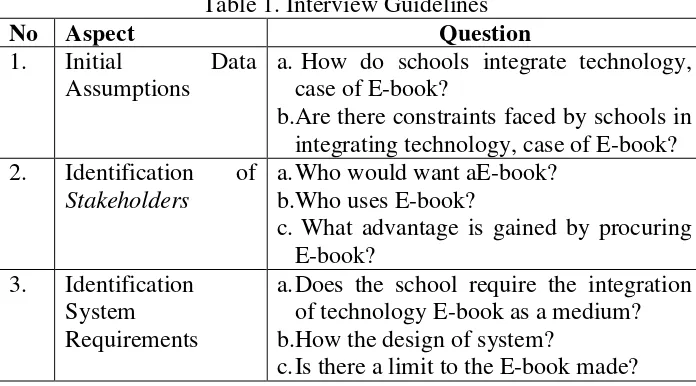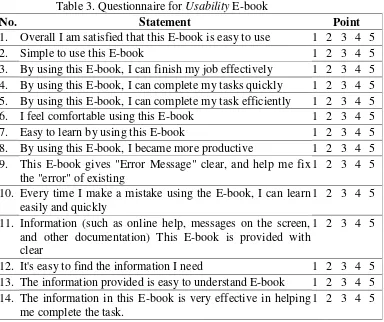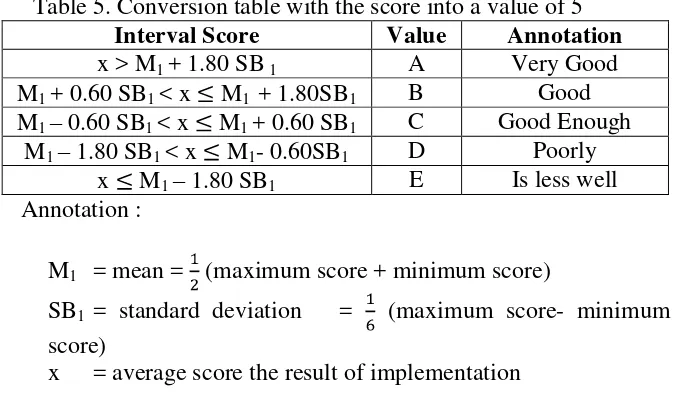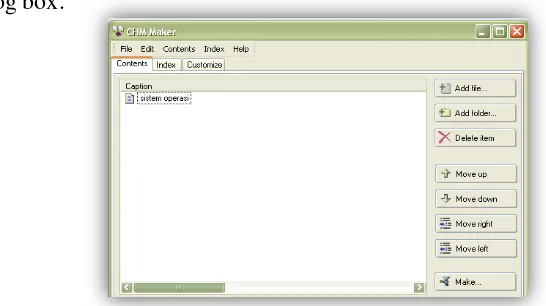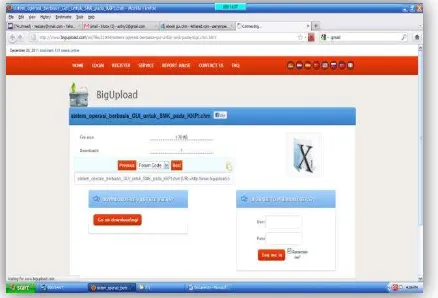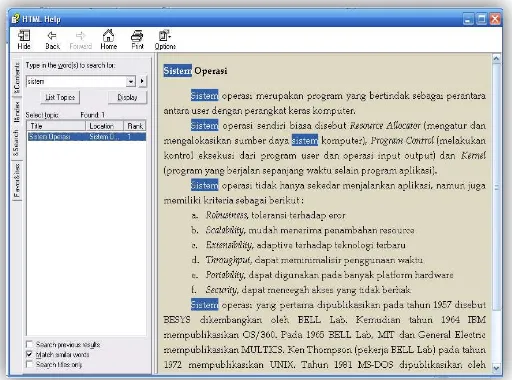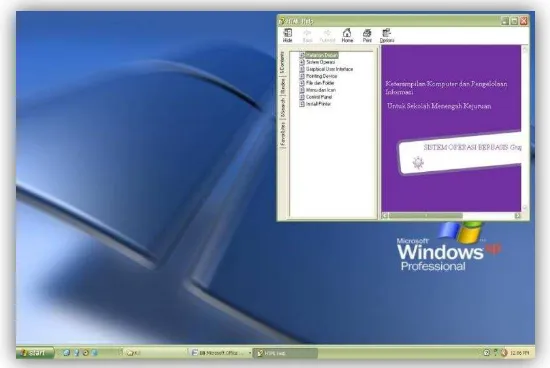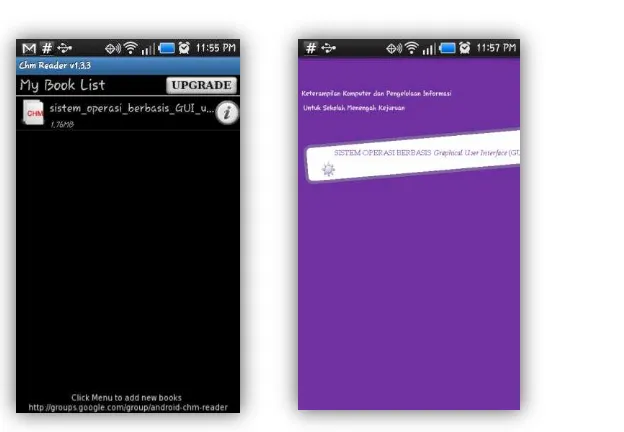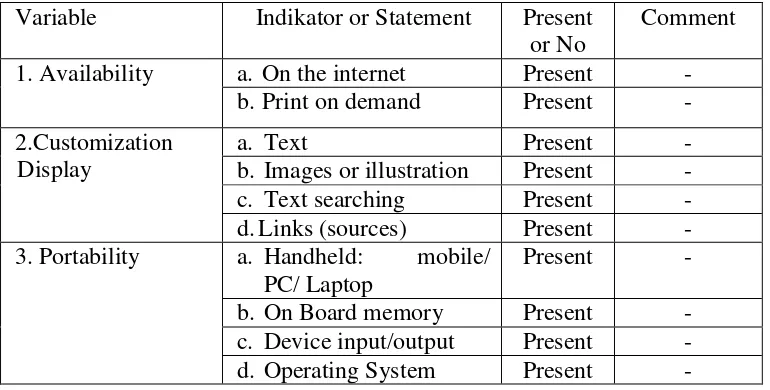Submitted as A Partial Fulfillment of Requirements for
The Attainment of A Sarjana Degree in Informatics Engineering Education
By :
ASTRI YULIANI 08520244029
INFORMATICS ENGINEERING EDUCATION STUDY PROGRAM ELECTRONICS ENGINEERING EDUCATION DEPARTMENT
ENGINEERING FACULTY YOGYAKARTA STATE UNIVERSITY
v
Real battle for success. Nothing is impossible.
Everything is possible, if you believe in God.
(Reza M Syarif)
to love someone is nothing
to be loved by someone is something
to be loved by someone we love is exciting
but, to be loved by ALLOH SWT is EVERYTHING
(inspired by Ray.exe)
Good books are more valuable than fine clothes. First Deserve and then Desire.
Study your present condition and know your weakness if you want to be strong.
vi
My God, ALLOH SWT (ARROSYIID)
BABE Suri and EMAK Sawi, my beloved parents,
My older sisters and my older brothers (Asmisih, Agus Umbarno,
Bambang Suroso and Sulami). My Nieces and Nephews (Galuh, Bita,
Tufa, Gadis).
ALL of My Friends and Family in the World
vii
By: AstriYuliani NIM. 08520244029
The integration of technology at learning process at SMK N 1 Sedayu quite less. The purpose of this research was to analysis the E-book quality. In this research the researcher analyze the E-book feasibility of E-book. The feasibility aspects were Availability, Customization Display, Portability and Usability.
The research was using descriptive quantitative method according to theories of E-book standard quality. The analysis of E-book passed through: (1)Implementation of E-book and (2)Analysis of E-book. This research was held from December 5th up to December 17th 2011. The data were collected in SMK Negeri 1 Sedayu. The respondents were 30 students from grade X of Computer and Network Engineering. Data collection for Usability used questionnaire with a 5 scale answer.
The result of interpretation from quantitative value was then converted into qualitative description value. The average score of students interpretation was 3.91 and this E-book was a Good E-book.
viii
the Almighty and the most Merciful, for all blessing and grace, without that I
would have never finished this thesis entitled “The Analysis of E-book Quality”.
Shalawat is always addressed to prophet Muhammad Shallallahu’alaihi wa
sallam, his family, friends and all moslems who always strive for following his
way and maintaining Sunnah.
My greatest thanks go to my parents for their endless love, support and
prayers along my 20 years of stepping on earth. My special gratitude goes to my
older sister, my older brother, Mr. and Mrs. Roni for their support and especially
my niece, my nephew for their laugh that cheers up our home.
I would like to express my great gratitude to Prof Rochmat Wahab, M. Pd.
M. A. as The Rector of University; Dr. Moch Bruri Triyono as The Dean of
Engineering Faculty; Handaru Jati, Ph. D. as my consultant in Informatics
Engineering Education Study Program; Masduki Zakaria, M. T., Umi Rochayati,
M. T., Mohammad Munir, M. Pd., Ratna Wardani, M. T. as lecturers in
Electronics Engineering Education; Andi Primeriananto, M. Pd. as Head of SMK
Sedayu; Isbani, S.Pd and Paulina Hendrajanti, S. Pd as teachers of Computer Skill
and Information Management Course; Nunik Sugesti, M. Hum. as my consultant
in English Education Department who have shared their valuable time, knowledge
and guidance with all their patience and wisdom during the process of
ix
I would like to extend my gratitude to all, whom I cannot mention one by
one, who have become parts of this long journey.
Finally, I realize that my thesis is far from being perfect. Therefore, I
would accept gratefully any comments and suggestions for the betterment of this
thesis.
Yogyakarta, January 2012
Writer,
x
APPROVAL ... ii
LEMBAR PERNYATAAN KEASLIAN ... iii
RATIFICATION ... iv
MOTTO ... ... v
DEDICATIONS ... vi
ABSTRACT ... vii
ACKNOWLEDGEMENT ... viii
CONTENT ... x
LIST OF FIGURES ... xii
LIST OF TABELS ... xiv
LIST OF APPENDIXS ... xv
CHAPTER I. INTRODUCTION ... 1
A. Background ... 1
B. Identification of The Problems... 2
C. Limitation of The Problems ... 2
D. Formulation of The Problems ... 3
E. Objectives of Research ... 3
F. Benefits of Research ... 3
CHAPTER II. Theoritical Review And Conceptual Framework... 4
xi
C. Conceptual Framework ... 13
D. Research Hypothesis ... 14
CHAPTER III. RESEARCH METHODOLOGY ... 15
A. Research Design ... 15
1. Research Methods ... 15
2. ResearchObject ... 15
3. Location and Time of Research ... 15
4. Respondents of Research ... 16
5. Research Procedures ... 16
B. Operational Definition of Research Variables ... 17
C. Techniques of Data Collection ... 17
D. Research Instruments ... 18
1. Research Instruments ... 18
2. Research Instruments Test ... 22
E. Data analysis Techniques ... 24
CHAPTER IV.FINDINGS AND DISCUSSION ... 27
A. FINDINGS ... 27
1. Implementation of E-book ... 27
2. Analysis of E-book ... 29
xii
B. Research Limitation ... 40
C. Suggestion ... 40
REFERENCES ... 41
xiii
Figure 2. The result of E-book implementation ... 28
Figure 3. Screenshoot E-book on the internet ... 29
Figure 4. Availability of indicator (print on demand) ... 30
Figure 5. Customization display indicator (text searching) ... 30
Figure 6. Portability indicator (Windows operating system)... 31
Figure 7. Portability indicator (Macinthos operating system) ... 32
Figure 8. Portability indicator (Linux operating system) ... 32
Figure 9. Portability indicator (E-book on Mobile) ... 32
xiv
Table 1. The interview guidelines ... 20
Tabel 2. Questionnaire for the E-book design ... 21
Table 3. Questionnaire for E-book Usability ... 22
Table 4. Interpretation the alfa correlation coefficient ... 24
Table 5. Conversion table with the score into a value of 5 ... 26
Table 6. Checklist for Availability, Customization Display and Portability ... 33
Table 7. The result of interpretation students to the Usability E-book ... 34
xv
2. The appendix of thesis consultant from Lecturer Consultant ... 45
3. The appendix of thesis consultant from Engineering Faculty ... 46
4. The appendix of research license from Engineering Faculty ... 47
5. The appendix of research license from SETDA DIY ... 48
6. The appendix of research license from BAPPEDA DIY ... 51
7. The appendix of research license from SMK N 1 Sedayu ... 52
8. The appendix of official statement from SMK N 1 Sedayu... 53
9. The appendix of assessor English Language Application... 54
10. The appendix of result and interview guidelines ... 55
11. The appendix of Usability instrument ... 58
12. The appendix of the result of Usability instrument ... 60
13. The appendix of Usability instrument graph ... 61
14. The appendix of statistic and descriptive analysis of Usability ... 62
15. The appendix of Availability criteria... 67
1 A. Background
Nowadays, the development of technology and science encourages
people to be able to respond and provide feedback to the developments. It
is unethical if human just shut the place and sit on our hands; human must
have the ability to respond to the changes. The ability to understand the
development of science and technology requires an intermediary medium
in the field of education.
Teachers should be able to integrate technology into the learning
process at school. Based on the observations at SMK Negeri 1 Sedayu
(GradeTen/ X, competency skills of Computer Network Engineering) the
integration of technology in the learning process was not maximum yet.
Due to the information age, human are expected to follow the changes for
example using an appropriate technology which is up to date. E-book is
one thing that becomes an example of technological development. The
E-book should be supported with electronic devices such as computers,
laptops, PDAs and software that is compatible with the E-book.
The use of E-book is not maximum among teachers and students
yet. Students didn‟t know the limitation of subject matter computer skill
and information management course quite well. Only some teachers
course. With the considerations above, it is necessary to analysis the
quality of E-book.
B. Identificationof The Problems
According to the description of background, the researcher
identified some problems as follows
1. The integration of technology of technology in vocational high
school quite less.
2. Students do not know the limitations of subject matter computer
skill and information management course quite well.
3. Not many vocational high school teachers develop subject matter
computer skill and information management course.
4. Ebook here has not been developed based on the E-book quality
standards.
C. Limitation of The Problems
Based on the identification of problems, the researcher decided to
analysis of E-book quality. It was analyze the E-book quality based on the
D. Formulation of The Problems
According to the limitation of the problem mentioned above, the
problems in the study of this development can be formulated as
1. How is the implementation of the E-book?
2. How is the E-book quality?
E. Objectives of Research
Based on the formulation of the problem which has been described
above in accordance with the principal issues to be discussed, the
objectives are
1. The implementation of the E-book
2. The E-book quality.
F. Benefits of Research
1. Practical Benefits
a. Getting result of a decent E-book design to support learning in the
computer skill and information management course for vocational
high school.
b. Producing E-book following the standard quality of E-book.
2. Theoretical Benefits
a. This research becomes the study or reference materials for students
at Yogyakarta State University and can be used as research
material for further research.
4
CHAPTER II
Theoritical Review and Conceptual Framework
A. Theoritical Review 1. E-book
E-book is a term used to describe a text analogous to a book that is
in digital form to be displayed on a computer according to Cox and
Mohammed, as quoted by Lee in the research of Anuradha (2005).
Anuradha (2005) also describes that E-book is a very good device for
teacher and student (in education case) with low hand dexterity. Looney
(2001) describes that E-book is a device specialized for displaying
electronic reading material or software designed to display such material.
Jan O. Borchers (1999) describes that an electronic book is a
portable hardware and software system that can display large quantities
of readable textual information to the user and that lets the user navigate
trough this information. Kumar (2009) describes that E-book is a digital
medium for communication of information, E-book is an example of
new developments envolved from conception to a reality with more to
come.
E-books can be defined as “any piece of electronic text regardless
of size or composition, excluding journal publications, made available
electronically or optically, for any device, hand-held or desk-bound that
Armstrong (2008) describes that E-book is a handheld electronic
device on which the text of a book can be read. Available in an
electronic format for reading, such : on a computer screen (available
only) and on the internet. The meaning of E-book by Birgit Lemken as
quoted by Wilson R. (2003) is a mobile, physical device to display
electronic documents.
According to the description above, the researcher assumes that
E-book is an application software that contains information. Available in
the internet and printed on demand. It needs such kind of hardware to
read an E-book. It should be user friendly when it is used by everyone.
2. E-book Quality
The design of electronic books is important in teaching materials in
the light of student use. Messing (1995), in his paper, reports some
reactions from studies that have been conducted. They are
a. Readability, the readability of computer screen and the desirability
of more subjects using the electronic medium.
b. Demarcation and annotation are key ingredients in making electronic
study books are desireable alternative to printed books.
c. Convenient Access, the evaluating like effectiveness of using
electronics books conclude that „making life easier‟ is one of benefit
convenient access.
d. Integration of Resouces, this appears to be an excellent use of
e. Traditional Learning Techniques, multimedia learning resources
provide students with a faster and easier access.
f. Production issues, do look at the production of electronics books but
only from point of view of creating a semi-automatic „book builder‟.
In terms of usability of users or readers, this point often gives
advantages for E-book. We can make it as one of the parameters to know
an E-book is proper to use. According to Borchers (1999)
a. Availability, the E-book is available and there are no more problems
with library and bookshop opening hours.
b. Searching, it is easy to find keyword.
c. Customization, it is possible for users to change display brightness
font size & style.
d. Portability, carrying additional titles does not mean additional
weight.
e. Multimedia, they include audio and video as well as arbitrary
extension with external applications can enhance an electronic book
in an integrated way of impossibility for printed version.
f. Environment, E-books require less environmental resources.
Tonkin (2010) investigates E-books and takes a look at recent
technology. Design choices include the following aspects:
a. Processor Speed
The processor speed influences document access and rendering,
b. Screen effective and levels of grayscale
Some screens offer eight shades of grey while others offer 16.
c. Operating System (OS)
Operating system and opportunity for software installation and
customization are further aspects.
d. On board memory and Expansion Capability
The amount of on board memory influences the number of E-books
that can be stored. Expansion capability determines in particular
the availability of a memory card slot.
e. Audio, capabilities may be added
f. Device input and output
The most basic device provides only a mechanism for moving
forwards and backwards in the book, turning to an index and
selecting items.
g. E-book availability and transfer mechanism
A few devices tie directly into distribution networks.
According to Snowhill (2001), outlines issues and
recommendations for making E-books viable over the long term in the
academic environment. They are
a. Content
E-book content should match any print version and include all its
elements: text, graph and illustration.
Use current formats for example (HTML, XML or PDF). A variety
of devices are being developed to replicate some of the virtues of
printed monographs, including portability and
network-independences, so that E-books themselves will function on variety
platforms.
c. Digital right management
DRM systems are either hardware or software (or both) that
enforces control over intelectual property, such as limit by user,
time, fee and or extent of content.
d. Access
Issues of access include user awareness and the ability to
accommodate simultaneous users.
e. Archiving and long term access
Two of the roles of academic libraries are building research level
collections and acting as archives research information.
f. Privacy
Users should not have to create individual accounts, but should
access and check out E-books.
g. The market and Pricing
Print on demand and one-times purchase of title with premium for
h. Enhancement and Ideal Features.
The functionality may be as varied as inclusion of multimedia
information, full text searching, mark-up, citation formatting,
reference linking, convenience, portability, interopability on
variety devices, availability in advance of print, advantages pricing
and the ability to share or loan information.
In delivery mechanism : (1)E-book can be read on dekstop, laptop,
handheld or specialist form (E-book reader/ device), (2)The use of
internet, (3)E-book can also delivered on diskette, CD-ROM and
memory card as well as over mobile telephone networks (Armstrong :
2008).
In the sub chapter of reading from screen, basic ergonomic issues
like flicker, image polarity and anti-aliasing made the way to improve
today‟s display (Lemken : 1999).
According to Kumar (2009), E-books are technology based books
which require hardware, software and a screen for display. (1)E-book
hardware: the use a monitor, LCD or touch screen device as screen.
(2)E-book reader software : function such as search, user define text size,
color/ greyscale display, network connection, read only content, hyperlink
and range of plaforms. (3)E-book creating software.
E-book provides equal access to learning materials to both
E-book, customization display, portability, integration multimedia,
distribute via internet (Kumar, 2009).
Armstrong (2008) describes the use of value-added features on
E-book for resource links, review links, editorial/feedback, author links,
education literature, links for journals, author biographics, companion
website, simulation/animation, exercises/questions, links to employments
sites. Electronics textbook design guidelines emerge with respect to the
use of structural element inherited from the paper medium, such as table
of contents and indexes, the provision of content summaries to enable
scanning, the use of colour and images to break the flow text and
implementing multimedia and interactive elements to engage users.
Wilson (2003) describes that quality standards of E-book are
(1)Functionalities of the software reader such as searching, bookmarking
and annotating. (2)Portability- student could access large amounts of
material “anytime, anywhere”. According to Connaway (2007)
Attractive features of E-books, 24/7 availability and the development and
distribution of E-books, therefore libraries must support multiple formats,
software, hardware and acquition, purchasing and usage models.
From all of theories above, the researcher assumed that the quality
standards of E-book are
1. Availability: (a) On the internet, (b) Print on demand
2. Customization Display: (a) Text, (b) Images or illustration, (c)
3. Portability: (a) Handheld : mobile/PC /Laptop, (b) On Board
memory, (c) Device input/output, (d) Operating System
4. Usability: Instrument using Computer System Usability
Questionnaire by Lewis, 1995.
B. Relevant Research
Anuradha (2005), in “Use of E-books in an Academic and Research Environment : a Case Study from the Indian Institute of Science”. The
purpose of this study is to investigate the use and usability of E-books from
user‟s perspectives in an academic and research environment.
Armstrong (2008), in “Books in a virtual world : The evolution of the e-book and its lexicon. Journal of Librarianship an Information Science” the
article looks at both the genesis of E-books and the stage of acceptance and
adaption that they have reached, with brief reference to third-generation
E-book readers available at the time of writing.
Chong (2008), in “E-book design preferencs : A case study” the purpose of this study is to investigate the student‟s preferences on page and
content design of E-books.
Dinkelman (2007),In “Accessing E-Books Trough Academic Library Website” examines access to electronic books as provided on the web sites of
Jenkins (2008), in “What is inhibiting the Proliferation of E-books in academic Library?” concludes that it is indubitable that E-books will
eventually play an integral role within academic libriaries.
Kumar (2009), in “E-books : Reader, Librarians an Publisher Perspective”, recognizes his paper with various types of E-book s available
and discusses various issues such as the technology required, standarization,
licensing and pricing.
Letchumanan (2011), in “Assesing the intention to use E-book among engineering undergraduates in Universiti Putra Malaysia, Malaysia”
Investigates the intention of using E-books as learning material among
undergraduates from an engineering department by using the technology
acceptance model (TAM) and gender as its external variable.
On Armstrong (2008) “Books in a virtual world: The evolution of the e-book and its lexicon. Journal of Librarianship an Information Science”,
Alan Kay (2005) describes that the concept on an E-book was born of the
need to overcome the limitation of papers.
Roesnita (2005), In “The Pattern of E-book Use Amongst Undergraduates in Malaysia: A Case of to Know is to Use” this exploratory
study focuses on identifying the usage pattern of E-books especially how,
when, where and why undergraduates at the Faculty of Computer Science and
Information Technology (FCSIT), University of Malaya (UM), Kuala
Lumpur use or do not use the E-books service provide by the University of
Tonkin (2010) in “E-books: Tipping or Vanishing Point?” investigates E-book and takes a look at recent technological and business
developments.
Whalley (2006) in “E-books for the Future: Here but Hiding?” outlines some developments in E-book technologies and links then to existing
ways of presenting textbook information.
C. Conceptual Framework
The development of technology and science in today's information
era, encourages people to be able to respond and provide feedback to all these
developments. Computer skills and management of information are the media
to keep up the development of technology, especially for members of the
vocational high schools. The integration of technology at grade X for
competency skills Computer Network Engineering is not maximum yet.
Electronic Book (E-book) is one technology that is developed at
this time to increase the integration of technology in vocational high schools.
The analysis of book must be appropriate with the quality standard of
E-book.
The research was using descriptive quantitative method according
to theories of E-book standard quality. The research procedures was
implementing and analysis the E-book. Product form of E-books that have
been produced according to the theory that acquired Availability,
of theory/ expert judgment with heuristic method to find that there are errors,
then tested to the user.
Once tested and obtained the research results and conclusions made
related reports analysis of E-book quality.
D. Research Hypothesis
Based on the theoritical review and conceptual framework, then the
hypothesis in this study is formulated as follows:
H0: The E-book fulfills the criteria (Availability , Customization Display, Portability and Usability) is suitable to use.
15
CHAPTER III
RESEARCH METHODOLOGY
A. Research Design
1. Research Methods
According to Sugiyono (2011: 2) A research method is basically
a scientific way to got the data with a specific purpose and usefulness.
The research was using descriptive quantitative method according to
theories of E-book standard quality. Based on conceptual framework,
the steps of this research study are implementing the E-book and
analysis the E-book.
2. Object Research
Understanding of the object of the research in general was a
problem of the topic of writing in order to compile a report. This study
was conducted to obtain data related to the object of research (Ajiyati,
2011). The object was examined in this study was quality of E-book.
3. Location and Time Research
a. Location of Research
The study was conducted at SMK N 1 Sedayu, Jl. Pos Kemusuk
Argomulyo, Bantul, Yogyakarta, particularly in grade X of computer
b. Research time
computer network engineering of SMK Negeri 1 Sedayu. Thirty people
are called small sample (Arikunto, 2007:94).
5. Research Procedures
The research procedures to be performed based on the research
method are
1) Implementation of E-book
The researcher implementing E-book using Abee CHM Maker
because this application software was easier than other E-book
maker. This software must be installed in our laptop/ PC, then
the software is opened and add files are added into the chm
Customization Display and Portability. Finally testing the
Usability of E-book using questionnaire.
B. Operational Definition of Research Variables
Research variables are basically everything that shaped what is
defined by researchers to be studied in order to obtain information about
them and then a conclusion (Sugiyono, 2011:38). Variable or object
investigated in this study was the E-book quality. There were any criteria
of the theories about the E-book quality. The researcher used the sub
variable Availability, Display Customization, Portability and Usability as
the standard criteria for quality of E-book in this research.
C. Data Collection Techniques
Data collection technique is the technique chosen by the researcher
in collecting the necessary data. This study usedmultiple data collection
techniques:
1. Interview
The researchers conducted interviews to obtain the data of the
needs of the E-book. According to Sugiyono (2011: 137) interview is
used as data collection technique if researchers want to conduct a
preliminary study to find a problem that must be investigated and if
researchers want to know the things of the respondents are more
The researcher used the free guided interview method, according to
Arikunto in Ajiyati (2011:53) that in conducting the interview, the
interviewer brings the guidelines that are only an outline of the things
that will be requested.
2. Questionnaire
According to Sugiyono (2011:142) questionnaire is a data
collection technique done by giving a set of questions or a written
statement to the respondent to answer. Type of questions used
researcher is a closed question, ie questions that expect an answer brief
or expect respondents to choose one alternative answer to the question
that has been available. The questionnaire in the form of a checklist was
used to test the implementation of E-book quality.
D. Research instruments 1.Research instruments
According to Arikunto (2007:164) in general, there are two types of
instruments. They are instruments prepared by the researcher, and the
second type is an instrument that has been standardized (standardized).
Research instrument is an invaluable tool for researchers in collecting
data. In general, the preparation of data collection instruments is carried by
the following steps (Arikunto, 2007: 134-135):
a. Conducting the identification of variables that exist in the formulation
of the research or the title listed on the problems of the research.
c. Finding indicators for each sub or the variable.
d. Arrange descriptors of each indicator.
e. Formulating each descriptor to become the instrument items.
f. Completing the instrument with the guidelines or instructions and
foreword.
Instruments used in this study are
a. Interview Guidelines
The interviews conducted in this study are free guided interview and
thus required an interview guide in the outline. Based on a course
module on Software Engineering by Restyandito quoted by Ajiyati
(2011: 54-55), the questions in an interview with the customer to
identify the needs of the software include:
1) The first question (identifying stakeholders)
a)Who would want a system/ program?
b)Who will use solution?
c)What are the economic benefits of a successful solution?
2) Questions to understand the problem
a) What are the characteristics of a good solution?
b) What problems are solved by the solution?
c) What is the condition of environment in which the solution is
implemented?
d) Are there any performance issues and constraints that affect a
Interview guides that researchers use in this study adopt the form of a
questionnaire with a list of questions stated by Restyandito in Ajiyati
(2011: 55) in outline as follows,
Table 1. Interview Guidelines
b.Are there constraints faced by schools in integrating technology, case of E-book? 2. Identification of of technology E-book as a medium? b.How the design of system?
c. Is there a limit to the E-book made?
The results of interview with one teacher of computer skill and
information management course is presented in the appendix.
2. Questionnaire
Questionnaires are a number of written questions used to obtain
information from respondents. The variable of questionnaire in this
research based on description of theories. The indicators describe for
testing the E-book to the appropriate of implementation. E-book contains a
checklist statement of appropriate quality assessment theory E-book
Table 2. Questionnaire for the design E-book
Variable Indikator or Statement Present or No
Comment
1. Availability a. On the internet b. Print on demand
The feasibility of E-book questionnaires were filled by the user and
set forth in the checklist with a Likert scale. Questionnaire for Usability
E-book (Lewis, 1995) shown as table 3.
Table 3. Questionnaire for Usability E-book
No. Statement Point
the "error" of existing
15. Organizing information in the "Screen" E-book clear 1 2 3 4 5 16. "Interface" This E-book is fun 1 2 3 4 5 17. I like to use "Interface" from this E-book 1 2 3 4 5 18. This E-book has all the functions and capabilities, I hope to
have this E-book
A valid instrument means a measuring tool used to obtain data
that are valid. Valid means the instruments can be used to measure
what should be measured.
Thoha (2003 : 109-110) states that a measuring instrument is
said to have validity if its content is appropriate measuring tools to
measure objects that should be measured and in accordance with
certain criteria.
The validity of this research instrument was tested from
variable design E-book (Availability, Display Customization and
the instruments which was used was valid because the researchers
used aquestionnaire derived from the international journal for
human interaction and computer-written by Lewis (1995). In terms
of Availability, Customization Display and Portability each point of
indicators need to be tested using Heuristic Judgement, matched the
implementation of E-book with the existing theory by E-book
reliability is typically considered tobe synonymous with the
consistency of the data produced by observations made by different
researchers (eg. interrater reliability), by the same researcher at
different times (eg. test retest) or by splitting a data set in two
parts".
The instrument is a reliable instrument when used several
times to measure the same object, will produce the same data
(Sugiyono, 2011:121). This point was used by the researcher to test
the reliability of Availability, Display Customization and
Portability E-book.
“For the instruments that can be given score and the score
just given one time only then the results analize with the alfa
Table 4. Interpretation the alfa correlation coefficient.
Alfa coefficient Reliability Level
0.800 – 1.000 Very High
0.600 – 0.799 High
0.400 – 0.599 Enough
0.200 – 0.399 Low
Less than 0.200 Very Low
The testing result of Usability instrument is 0.609 with N =
19 so the reliability level is High. The Usability Instrument for data
collection was reliable to used.
E. Data Analysis Techniques
Sugiyono (2011:147) mentions that after the data were collected,
including analysis of data from all respondents or other sources of data
was to know the criteria eligibility based on quality of E-book. Activities
in the data analysis were: grouping data based on the variables and types
of respondents, tabulating data based on the variable studied, doing the
calculations to answer the formulation of the problem and taking measures
to test the hypotheses that have been proposed.
The activities in the data analysis according to Nugraha (2005) in
Ajiyati (2011) are
1. Data collection, all research data collected
2. Editing data, if there is no logical answer
3. Encoding the data, transforming data into numbers of questionnaires
4. Data processing,
a. Grouping data based on variables and data types, quantitative and
qualitative (suggestion)
b. Tabulating data, the present Usability into the table.
c. Calculating the average quantitative
Arikunto (1999) in Ajiyati (2011) mentions that to know
average scores and average scores overall.
d. Convert the average value of quantitative data in qualitative
Here is a conversion table with the score into a value of 5,
Table 5. Conversion table with the score into a value of 5
Interval Score Value Annotation
x > M1 + 1.80 SB 1 A Very Good
M1 + 0.60 SB1 < x M1 + 1.80SB1 B Good
M1 – 0.60 SB1 < x M1 + 0.60 SB1 C Good Enough
M1 – 1.80 SB1 < x M1- 0.60SB1 D Poorly
x M1 – 1.80 SB1 E Is less well
Annotation :
M1 = mean = (maximum score + minimum score)
SB1 = standard deviation = (maximum score- minimum
score)
27
FINDINGS AND DISCUSSION
A. FINDINGS
1. Implementation of E-book
In the process in making E-book, it was necessary to identify the needs
of E-book. According to the result of interview with the teacher of
computer skill and information management course, the researcher got the
information about E-book specification which is needed by SMK N 1
Sedayu. Some materials of computer skill and information management
for grade X has not been organized, which consists of several stand-alone
files.
In order to improve the quality of teaching and learning process in
technology-based vocational school, the researcher made the E-book
according to the E-book quality standards. They are availability,
customization display, portability and usability.
The needs are laptop or personal computer (PC) to make E-book, web
browser to access to E-book availability, application software Abee CHM
Maker, Microsoft Office Word to make E-book and USB flashdisk to save
Below is the figure of implementation of design with button, tool bar,
menu bar, text searching, links, index, content, information or matter and
dialog box.
Figure1. The application of software to make an E-book.
The researcher implementing E-book using Abee CHM Maker
because this application software was easier than other E-book maker.
This software must be installed in our laptop/ PC, then the software is
opened and add files are added into the chm maker. The matter is written
in Microsoft Office Word and then saved in web page format so it can
opened in chm maker. Below is the result of implementation of the
E-book in .chm format :
a. Availability
The E-book can be displayed on a computer and an electronic format.
It should be online, offline and print on demand. There are no more
problems with library and bookshop opening hours. Transfer
mechanism can be copied on PC and download via internet.
1) On the internet.
Researcher posted the E-book on Uniform Resource Locator (URL).
Url :
- http://www.bigupload.com/en/file/21904/sistem-operasi-berbasis-gui-untuk-smk-pada-kkpi.chm.html
- http://www.4shared.com/file/HDvHLjAk/E-book_gui.html below is the screenshot :
Figure 3. Screenshot E-book on the internet
2) Print on Demand.
The matter on E-book was available in advance of printing. Below,
Figure 4 . Availability indicator (print on demand)
b. Customization Display
The customization display made the user feel comfortable when
using the E-book. The E-book contains text, menu bar, toolbar and text
searching. Links, source and images must be presented on an E-book.
The components of customization display are shown below:
c. Portability
1) Handheld : Mobile/ PC/ Laptop, the E-book was handheld, present
on PC and Laptop by copying
2) On board memory, the expansion capability of processor, about
the speed of opening the E-book. It was presentin small size of file
only 1.76 MB.
3) Device input/output, the E-book can copied via USB/VCD so it
should become input on PC or Laptop. Actually it will be shown
on the screen.
4) Operating System, E-book can be used in Windows, Macintosh
and Linux.
Figure 7. Portability indicator (Macinthos operating system)
Figure 8. Portability indicator (Linux operating system)
Based on the result of E-book, the result is presented in the table below:
Tabel 6.Checklist for Availability, Customization Display and Portability.
Variable Indikator or Statement Present
or No
b. Images or illustration Present -
c. Text searching Present -
The indicators of availability, customization display and portability were
fulfilled. The last indicator of this research is usability. To determine
whether the E-book can be used or not, it should be tried by user. In this
research the users were students of vocational high school. The researcher
used thirty samples to the level of usability of E-book.
The usability instruments were taken from the international journal
for human interaction and computer-written by Lewis (1995). The number
of questions are 19.
The purpose of this research was to determine the feasibility of E-book
testing. The testing used heuristic judgements.
The research method in this research was Descriptive Quantitative. The
research was held in SMK Sedayu with 30 respondents from grade X of
Computer Network Engineering. The research was held from December 5th up
to December 17th 2011. The data collection techniques were interview,
checklist and questionnaire. The research instruments were interview guides
and questionnaires. Data collection used Likert scale. The data analysis was
quantitative descriptive analysis.
The result of thirty samples shown as table 7. The data were collecting
after the students of the vocational high school was using the E-book.
Table 7. The result of interpretation students to the Usability E-book .
Those Usability data shown as figure 10, like below :
Figure 10. Trunk diagram of Usability E-book interpretation from student.
Based on the conversion of formula, we can make a table with content
by changing quantitative data to qualitative data.
Table 8. Conversion table with the score into a value of 5 in numbering
Interval Skor Value Annotation
x > 4.21 A Very Good
x= average score the result of implementation = 3.91
got average score value from student 3.91 and based on conversion interval value.
So the E-book obviously was Good.
Based on the research hypothesis, the researcher concludes that E-book
on computer skill and information management course is fulfills the criteria
(Availability , Customization Display, Portability and Usability) and was suitable
to use.
3. Hypothesis authentification
There are two hypothesis that propose by the reearcher. (1) Ho = The
E-book fulfills the criteria (Availability , Customization Display, Portability and
Usability) is suitable to use (2) H1 = The E-book does not fulfills the criteria
(Availability , Customization Display, Portability and Usability) is not suitable to
use.
In the variable of Availability indicator of on the internet and print or
demand is fulfills. In the variable of Customization Display indicator of text,
image or illustration, text searching and link (sources) is fullfills. In the variable of
Portabilty indicator of handheld (Mobile, PC, Laptop), On board memory, device
input/output and operating system is fulfills. In the variable of Usability the
findings is good based on the average score.
So, based on the findings and discussion, the researcher conlude that the
E-book template fulfills the criteria (Availability, Customization Display,
“Digitizing Education A Primer on E-books”
The researcher discussed about this E-book research by comparing it with
the points of view about E-book by Michael A. Looney and Mark Sheehan.
Electronic reading materials -E-books- were real today and many elements of the
vision were only months away. Digital learning content was about to overtake the
education market place and change the way of we distribute and interact with
information and ultimately, the way we learn.
E-book was either a device specialized for displaying electronic reading
material. If the publisher of author allows it, E-book accessed by E-book reader
software may be printed, loaned or given away to friends or colleagues.
The software may allow bookmark and annotate content, conduct quick
searches and look up words in an integrated dictionary that can read words and
phrases back to synthetic speech.
In the meantime, tens of millions of PCs, but especially windows and
machintos laptops, make excellent E-book device through the use of free,
downloadable software featuring tools for individualizing text-resolution
preferences.
E-books (in the broad sense of electronic content) were ideal for the
academic environment. A number of social and economic factors make E-books
or digital content preferable to paper text -books and course materials- or at least
highly desirable as adjuncts to these materials. E-books can enable daily, weekly,
will be required to make E-books successful generally and also in higher
education: content, accessibility and readability.
“E-Book on Computer Skill and Information Management Course for Vocational High School”
Computer skill and information management course is one of many course
in the curriculum of vocational high school. The developments of technology
become an indicator to adapt the matter in the learning process. In the school
environment the students must proactive to support the learning process.
However, the teachers always guide the students to overcome the problems they
find in the learning process.
The research about E-book maybe one of the solutions for increasing
learning media. On the other hand, this E-book must be developed. In the next
research the researcher has a plan to create an E-book in other courses.
Teachers can expand the matter according to the syllabus. It makes the
students more active in the learning process. The elements on E-book appearances
also must be increased. The E-book fulfilled the standard quality of E-book, they
were availability, customization display, portability and usability. In the next
research, the indicators must be added. In the future, the E-book (in this research)
can be expanded not only for vocational high schools. The E-book can be used in
39
CHAPTER V
CONCLUSION AND SUGGESTION
A. CONCLUSION
Based on the result of research and discussion, it is concluded that
1. The researcher implementing E-book using Abee CHM Maker because
this application software was easier than other E-book maker. This
software installed in our laptop/ PC, then the software is opened and
add files are added into the chm maker. The matter is written in
Microsoft Office Word and then saved in web page format so it can
opened in chm maker. Finaly, the E-book save as .chm format.
2. (a) In the variable of Availability indicator of on the internet and print
or demand is fulfills. (b) In the variable of Customization Display
indicator of text, image or illustration, text searching and link (sources)
is fullfills. (c) In the variable of Portabilty indicator of Handheld
(Mobile, PC, Laptop), On board memory, device input/output and
operaing system is fulfills. (d) In the variable of Usability the findings
is good (3.91) based on the average score.
So, based on the findings and discussion, the researcher conluded
that the E-book fulfills the criteria (Availability, Customization Display,
B. LIMITATION OF RESEARCH
1. The research objects were Availability, Customization Display,
Portability and Usability.
2. The respondents of research was thirty students.
3. The E-book was tested with heurisctics judgement.
C. SUGGESTION
1. The indicator must be added for the next research.
2. The E-book should be compared with the other media.
3. The testing must be added, not only heuristics judgements.
4. The E-book got title “good”, it would be suggested to apply in schools.
41
REFERENCES
Ajiyati, A.N.(2011). Pengembangan Sistem Informasi Akademik Berbasis Short Message Service (SMS) Interaktif sebagai media layanan informasi akademik di SMP Negeri 2 Bambanglipuro, Skripsi. Faculty of engineering, State University of Yogyakarta
Anuradha, K.T. & Usha, H.S. (2005). Use of e-books in an academic and research environtment : a case study from the Indian Institute of Science. Accessed on October 2011 available at
http://eprints.iisc.ernet.in/5890/1/ebook1-final.pdf
Arikunto, Suharsimi. (2007). Manajemen Penelitian. Jakarta : Rineka Cipta.
Armstrong, chris. (2008). Books in a virtual world : The evolution of the e-book and its lexicon. Journal of Librarianship an Information Science, 40 (3) September 2008.Accessed on October 2011 available at
http://lis.sagepub.com/content/40/3/193
Borchers, Jan O. (1999). Electronic Nooks : Definition, Genres, Interaction Design Patterns. Linz University, Austria. Accessed on September 2011 Available at
Connaway, Lynn S. & Wicht, Heather L. (2007). What Happened to the E-Book Revolution? : The Gradual Integration of E-books into academic Libraries. Accessedon October 2011. Available at http://dx.doi.org/10.3998/3336451.0010.302
Dinkelman. (2007). Accessing E-Books Trough Academic Library Website.
Accessed on October 2011 available at
http://crl.acrl.org/content/68/1/45.full.pdf+html
Jenkins, Alanna. (2008). What is Inhibiting in Proliferation of E-books in the Academic Library? Vol 1, No.1. Accessed on October 2011 available at
Kumar,S. et. Al. (2009). E-Books : Readers, Librarians and Publishers Perspective. Accessed on October 2011 available at http://crl.du.ac.in/ical09/papers/index_files/ical-among engineering undergraduates in Universiti Putra Malaysia, Malaysia” Library Hi Tech, vol. 29 Iss: 3, pp.512-528. Accessed on
October 2011 available at
http://emeraldinsight.com/journals.htm?articleid=194912&show=abstr act
Looney, Michael A. & Sheehan Mark. (2001). Digitizing education a primer on ebooks. Accessed on September 2011 availaable at http://net.educause.edu/ir/library/pdf/erm0142.pdf
Messing, John. (2000). Measuring Student Use of Electronic Books. Accessed on
October 2011 available at ht
tp://www.ascilite.org.au/conferences/melbourne95/smtu_bak/papers/ messing.pdf
Snowhill, (Lucia). 2001. E-books and Their Future in Academic Libraries.
Accessed on October 2011. Available at
http://www.dlib.org/dlib/july01/snowhill/07snowhill.html
Sugiyono. (2011). Metode Penelitian Pendidikan Pendekatan Kuantitatif, Kualitatif dan R&D. Bandung : Alfabeta.
Thoha, Chabib. (2003). Teknik Evaluasi Pendidikan. Jakarta : Raja Grafindo Persada.
Tonkin, Emma. (2010). eBooks : Tipping or Vanishing Point?. Accessed on October 2011. Available at http://www.ariade.ac.uk/issue62/tonkin/
Whalley, Brian. (2006). E-Books for the Future : Here But Hiding?. Accessed on October 2011. Available at http:// www.ariade.ac.uk/issue49/whalley/
3.20 3.30 3.40 3.50 3.60 3.70 3.80 3.90 4.00 4.10 4.20 4.30
1 3 5 7
9 11 13
15 17 19
21 23 25 27 29
M
e
an
Reliability Statistics
Cronbach's
Alpha N of Items
.609 19
Case Processing Summary
N %
Cases Valid 30 100.0
Excludeda 0 .0
Total 30 100.0
a. Listwise deletion based on all variables in the
procedure.
Item Statistics
Mean Std. Deviation N
numb.1 3.93 .254 30
numb.2 4.00 .371 30
numb.3 3.97 .556 30
numb.4 3.83 .747 30
numb.5 3.87 .434 30
numb.8 3.73 .583 30
numb.9 3.70 .750 30
numb.10 3.93 .521 30
numb.11 4.07 .450 30
numb.12 4.13 .571 30
numb.13 4.13 .776 30
numb.14 3.90 .481 30
numb.15 3.90 .923 30
numb.16 3.50 .820 30
numb.17 3.40 .770 30
numb.18 3.97 .809 30
Scale Statistics
Mean Variance Std. Deviation N of Items
74.20 17.821 4.221 19
Descriptive Statistics
N Range Minimum Maximum Sum Mean
numb.1 30 1 3 4 118 3.93
numb.2 30 2 3 5 120 4.00
numb.3 30 2 3 5 119 3.97
numb.4 30 3 2 5 115 3.83
numb.5 30 2 3 5 116 3.87
numb.6 30 2 3 5 124 4.13
numb.7 30 2 3 5 120 4.00
numb.8 30 2 3 5 112 3.73
numb.9 30 2 3 5 111 3.70
numb.10 30 2 3 5 118 3.93
numb.11 30 2 3 5 122 4.07
numb.12 30 2 3 5 124 4.13
numb.15 30 3 2 5 117 3.90
numb.16 30 3 2 5 105 3.50
numb.17 30 3 2 5 102 3.40
numb.18 30 3 2 5 119 3.97
numb.19 30 2 3 5 123 4.10
Valid N (listwise) 30
Descriptive Statistics
Std. Deviation Variance
numb.1 .254 .064
numb.2 .371 .138
numb.3 .556 .309
numb.4 .747 .557
numb.5 .434 .189
numb.6 .571 .326
numb.7 .643 .414
numb.8 .583 .340
numb.9 .750 .562
numb.10 .521 .271
numb.11 .450 .202
numb.14 .481 .231
numb.15 .923 .852
numb.16 .820 .672
numb.17 .770 .593
numb.18 .809 .654
